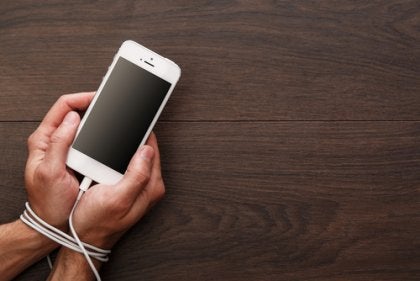New Addictions: Classification and Intervention

Addiction is one of the biggest psychological problems, not to mention the most difficult to treat. Abstinence is so uncomfortable that it’s very complicated for patients not to give in to their addictions. In addition to the classic addictions that everyone is familiar with, ducha as drugs or gambling, there are addictions that have only recently come onto the scene.
Drugs have the power to provide the brain with powerful instant gratification in the short-term. Not only that, but they’re also able to relieve negative feelings. For example, you might seek out the drugs that make you feel good if you get some bad news or have a bad day. The same goes for boredom and anger. Through a process of negative reinforcement, drugs dull the feelings that you don’t want to tolerate. That’s how you become dependent.
More and more people nowadays can’t tolerate the discomfort of wanting something. Whether it’s information from someone in your social networks, hunger, or the need to be productive, to give a few examples.
These new addictions aren’t part of the diagnostic classification system yet, but it’s very possible that they’ll be included in the near future. In fact, they present the same clinical traits as substance addction: loss of control over your behavior, psychological dependence, tolerance, and abstinence.

Some types of new addictions
Now, we’ll tell you about some types of new addictions proposed by author Vicente Caballo. It’s possible that you’ll identify with some of them because they have become a part of most people’s day-to-day lives. What’s more, they’re completely legal and normalized.
Nevertheless, it’s important to identify these addictions and fight against them. If we don’t do it in time, they become chronic and may affect your social and family relationships and can cause problems at school and work.
Internet addiction
An individual is addicted to the Internet when they use it less to find information and more as a kind of psychological escape from their real lives.
Individuals with internet addiction spend between 4 and 80 hours a week surfing the web. Some sessions can last up to 20 hours. They tend to use stimulants such as coffee to be able to stay up longer. People with Internet addiction usually hide their behavior and feel an intense need to use the Internet. Some people who are addicted to the Internet suffer health consequences such as carpal tunnel syndrome.
There are specific categories of Internet addiction, such as cybersex addiction or chatroom addiction. The latter provides a sense of intimacy and connection for the user. The feeling of being accepted into a group is very important.
Cell phone addiction
Cell phones provide constant stimulation to the brain’s reward centers. Everything is in real-time and immediate. When people use their cell phones, they feel accepted by their digital community. That’s one of the reasons why they’re so addictive.
Recovering from cell phone addiction is actually one of the most complicated addiction recovery processes. That’s because cell phones are so common nowadays that they’ve become a true necessity.
Food addiction
Also called “hyperphagic addictions”, they’re characterized by voracious eating, eating huge amounts of food without feeling physical hunger. It involves eating until you feel uncomfortably full, guilty, and bad about yourself.
Food addictions tend to be the result of stressful moments or long-term stressors as well as depression. Consequently, food addicts prefer fast-metabolizing hydrocarbonates (sweets, dairy products, etc.) that stimulate serotonergic activity.

Work addiction
Work addicts have an incessant need to feel productive. That makes them work impulsively and constantly. They feel irritated when they’re on vacation and they have cognitive distortions regarding how much work they have to do. For example, someone addicted to work might think “If I don’t go to the meeting and finish all the reports by tomorrow, I’ll be a failure”. Low self-esteem and perfectionism have a lot to do with work addiction.
Other new addictions include sex addiction, shopping addiction, or exercise addiction.
Treating these new addictions
Given that behavioral addictions are similar to chemical addictions in terms of how the addiction starts and how it’s maintained, intervention programs are similar.
Echeburua, Corral, and Amor (2005) wrote an interesting article about behavioral addictions and treatment.
The end goal of treatment is not total abstinence, like in chemical addiction. The goal, rather, is for the patients to relearn behavior that’s necessary for daily life.
The program involves the following: motivation for change, analyzing the stimuli associated with addiction, controlling said stimuli, and exposure and learning strategies to solve specific problems and prevent relapse.
For technological addiction problems, experts have more specific recommendations. They are: break connection habits, set goals for a realistic tech use schedule, use external alarms and reminders to disconnect, etc. If the problem is a specific application, then the addict has to abstain from using the app without stopping the use of the device itself.
All cited sources were thoroughly reviewed by our team to ensure their quality, reliability, currency, and validity. The bibliography of this article was considered reliable and of academic or scientific accuracy.
- Caballo, V. (2014). Manual de psicopatología y trastornos psicológicos. Edición Pirámide. 2º edición
This text is provided for informational purposes only and does not replace consultation with a professional. If in doubt, consult your specialist.








